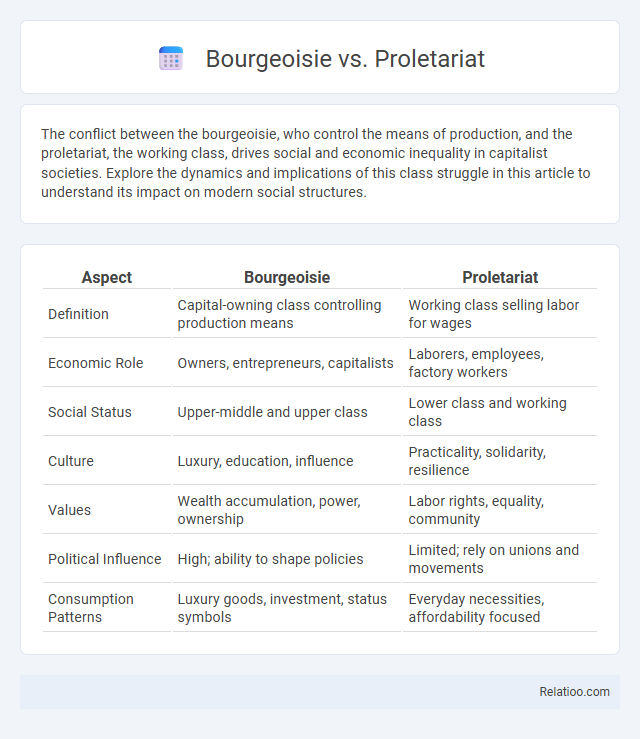The conflict between the bourgeoisie, who control the means of production, and the proletariat, the working class, drives social and economic inequality in capitalist societies. Explore the dynamics and implications of this class struggle in this article to understand its impact on modern social structures.
Table of Comparison
| Aspect | Bourgeoisie | Proletariat |
|---|---|---|
| Definition | Capital-owning class controlling production means | Working class selling labor for wages |
| Economic Role | Owners, entrepreneurs, capitalists | Laborers, employees, factory workers |
| Social Status | Upper-middle and upper class | Lower class and working class |
| Culture | Luxury, education, influence | Practicality, solidarity, resilience |
| Values | Wealth accumulation, power, ownership | Labor rights, equality, community |
| Political Influence | High; ability to shape policies | Limited; rely on unions and movements |
| Consumption Patterns | Luxury goods, investment, status symbols | Everyday necessities, affordability focused |
Defining the Bourgeoisie and Proletariat
The bourgeoisie refers to the capitalist class that owns the means of production and controls economic resources, while the proletariat comprises the working class who sell their labor for wages. Class difference is fundamentally rooted in ownership and control over production, creating a division between those who accumulate wealth through capital and those who depend on labor for survival. This dynamic shapes power relations and social structures within capitalist societies.
Historical Origins of Class Conflict
The historical origins of class conflict trace back to the emergence of the bourgeoisie as the wealthy capitalist class controlling production means during the Industrial Revolution, contrasting sharply with the proletariat, the working class subjected to wage labor and exploitation. Karl Marx's theory emphasizes this dichotomy as the foundation of socioeconomic struggles, where class differences stem from ownership of production resources, power dynamics, and wealth distribution. This conflict shaped modern class divisions, illustrating systemic inequalities between the bourgeoisie and proletariat that drive social and economic change.
Marxist Theory and Class Struggle
Marxist theory defines the bourgeoisie as the capitalist class owning the means of production, while the proletariat constitutes the working class selling labor for wages. The class difference creates inherent conflict known as class struggle, where the proletariat seeks to overthrow bourgeois dominance and achieve economic equality. Your understanding of this dynamic reveals the ongoing tension and power imbalance central to Marxist analysis of societal structures.
Economic Power and Social Relations
The bourgeoisie controls economic power through ownership of production means, enabling wealth accumulation and influence over labor markets. The proletariat sells labor for wages, lacking asset ownership and facing economic dependency on bourgeois employers. This class difference shapes social relations by creating hierarchy, power imbalances, and conflicts driven by economic inequality and access to resources.
The Role of Capital in Shaping Society
The bourgeoisie control capital and means of production, dictating economic power and social influence, while the proletariat sells labor to survive, leading to inherent class conflict. Capital accumulation by the bourgeoisie drives social stratification and perpetuates inequality, shaping societal norms and opportunities. Your understanding of this dynamic reveals how economic structures determine class relations and influence social mobility.
Labor, Exploitation, and Alienation
The bourgeoisie controls the means of production, extracting surplus value from proletarian labor through exploitation, resulting in economic and social class differences. Your labor becomes a commodity within this system, causing alienation as workers lose connection to both the product and the production process. This class conflict underpins systemic inequality, where the proletariat's efforts generate wealth primarily benefiting the bourgeoisie.
Political Influence of the Bourgeoisie
The bourgeoisie wields significant political influence through control of economic resources, enabling them to finance campaigns, lobby policymakers, and shape legislation that preserves their interests. This dominant class often secures favorable policies such as tax benefits and regulatory advantages that widen the class difference, reinforcing systemic inequalities between themselves and the proletariat. Your awareness of these power dynamics is crucial for understanding how political structures maintain class hierarchies and impact social mobility.
Revolutionary Movements and Proletarian Uprising
The bourgeoisie controls the means of production, creating economic disparities that fuel class conflict with the proletariat, who sell their labor to survive. Revolutionary movements often emerge as the proletariat organizes to challenge bourgeois dominance, seeking to dismantle class structures and redistribute wealth. Your role in recognizing these dynamics can support or resist proletarian uprisings aimed at achieving social and economic equality.
Bourgeoisie vs Proletariat in Modern Society
The bourgeoisie, owning the means of production and capital, dominate economic resources and political power in modern society, while the proletariat primarily sells labor for wages, facing economic dependency and limited upward mobility. Class differences manifest in income inequality, access to education, healthcare, and social capital, reinforcing systemic disparities between these groups. Contemporary analyses highlight how globalization and technological advancements intensify exploitation and precarious labor conditions for the proletariat, deepening class stratification.
Future Trends in Class Dynamics
The future of class dynamics is shaped by the shifting roles of the bourgeoisie and proletariat amid technological advances and globalization, which increasingly redefine labor value and capital control. Innovations such as automation and AI are likely to exacerbate income disparities, challenging traditional class structures by reducing demand for manual labor and expanding opportunities for capital ownership. Understanding these trends empowers you to anticipate changes in socioeconomic status and navigate the evolving landscape of class relations effectively.

Infographic: Bourgeoisie vs Proletariat
 relatioo.com
relatioo.com